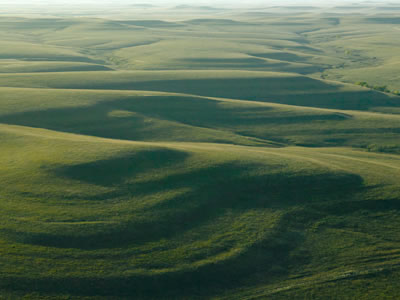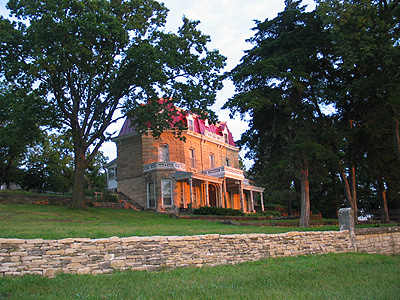Rural Culture Elements represented: Geography, history
The Tallgrass Prairie National Preserve is one of The 8 Wonders
of Kansas because it represents the last significant example of the
tallgrass prairie in North America!
Prairies began appearing in the mid-continent from 8,000 to 10,000
years ago and have developed into one of the most complicated and
diverse ecosystems in the world, surpassed only by the rainforest of
Brazil. Tallgrass prairie once covered approximately 170 million acres
of North
America. It was the continent's largest continuous ecosystem supporting
an enormous quantity of plants and animals. Some of the grasses include
Big Bluestem, Indian Grass, and Switch Grass and they can grow to
heights of
eight feet in the fall, depending on the moisture and other factors.
Man discovered the rich soils that exist in the prairies about 150
years ago. Finding the prairie soils outstanding for crop production,
they plowed
the prairie everywhere they could for the production of wheat, corn,
and other domestic crops. Less than 4% now remains, mostly in the Flint
Hills of Kansas. This makes it one of the rarest and most endangered
ecosystems in
the world.
On November 12, 1996, legislation created the 10,894 acre Tallgrass
National Prairie Preserve to protect a sample of once vast tallgrass prairie ecosystem.
The Tallgrass National Prairie Preserve also safeguarded cultural
history with the restoration of cattleman Stephen F. Jones' ranch
called Spring Hill Farm and Stock Ranch. Tours of his 1881 limestone
Second Empire house, the three-story limestone barn, and other
outbuildings add to the experience of a visit here.
A wide variety of educational programs and tours are offered to help
the public learn about the cultural and natural history of this area.
To experience more of the Flint Hills drive the 47-miles of the Flint
Hills National Scenic Byway on K-177 between Council Grove and Cassoday.
Location: 2 miles north of Strong City on K-177 or 17 miles south of Council Grove on K-177. Use this link for correct map location:
https://goo.gl/maps/rzJmguhmmAK2
Contact: 620.273.8494
Fee: No admission charge
Hours: May-October 8:30a.m.- 4:30p.m.;
Winter hours 9 a.m.-4:30 p.m.


